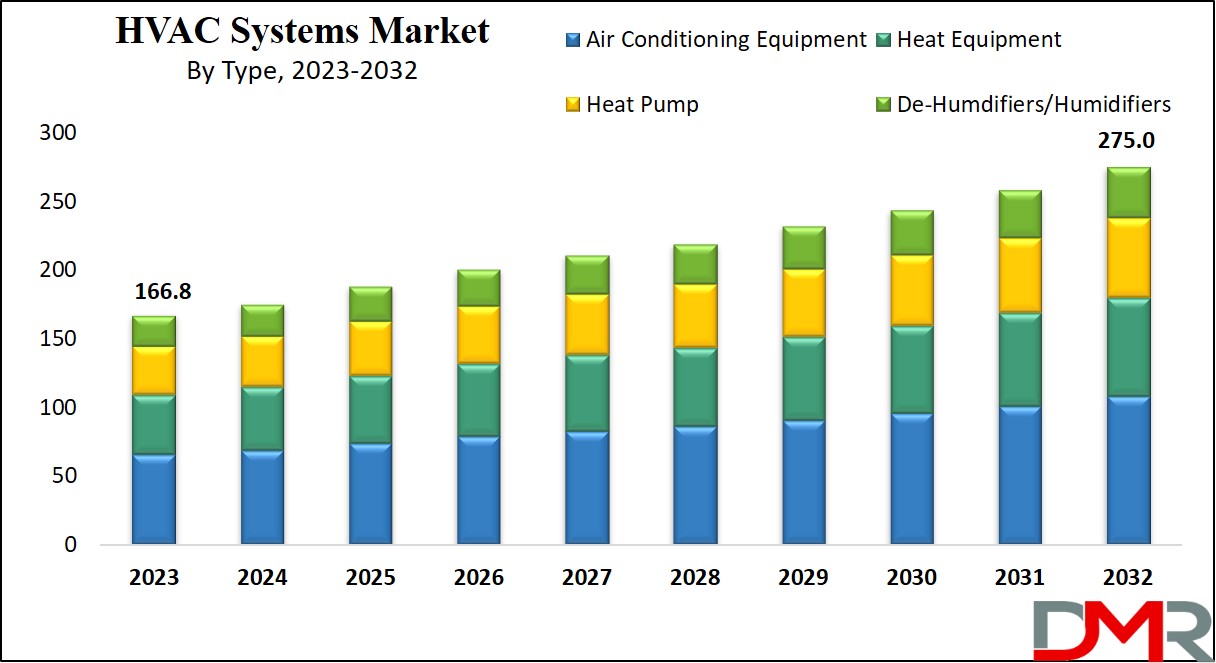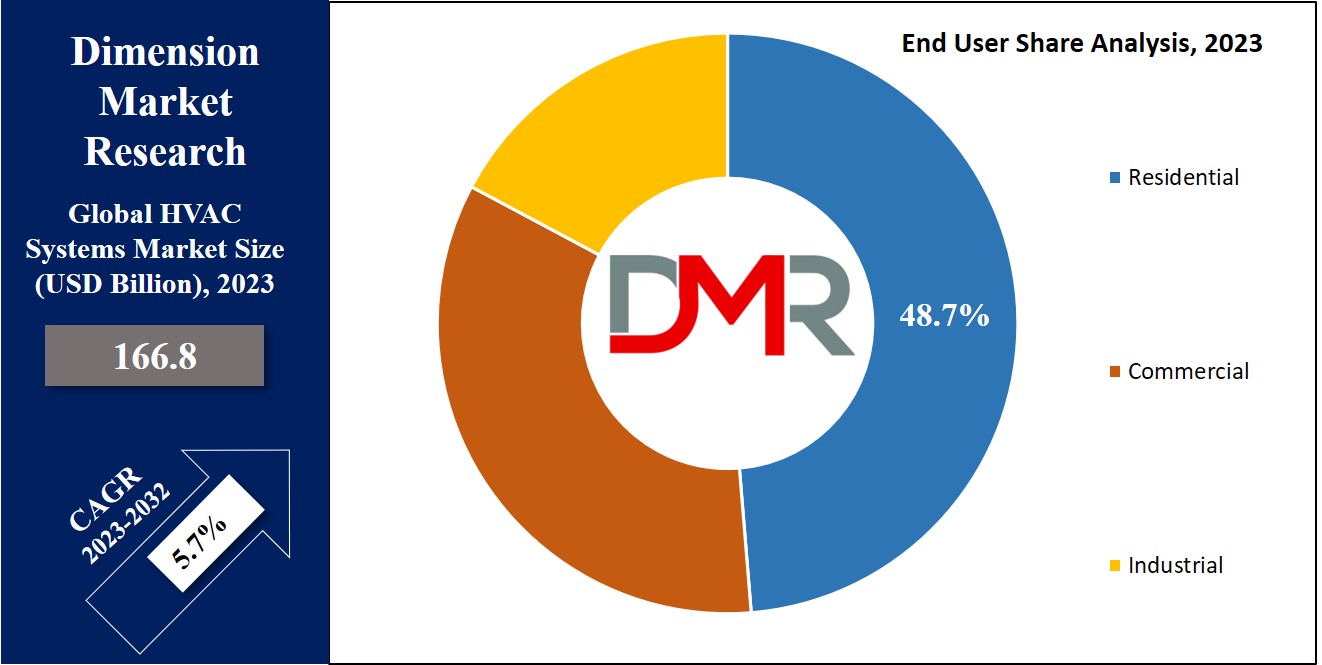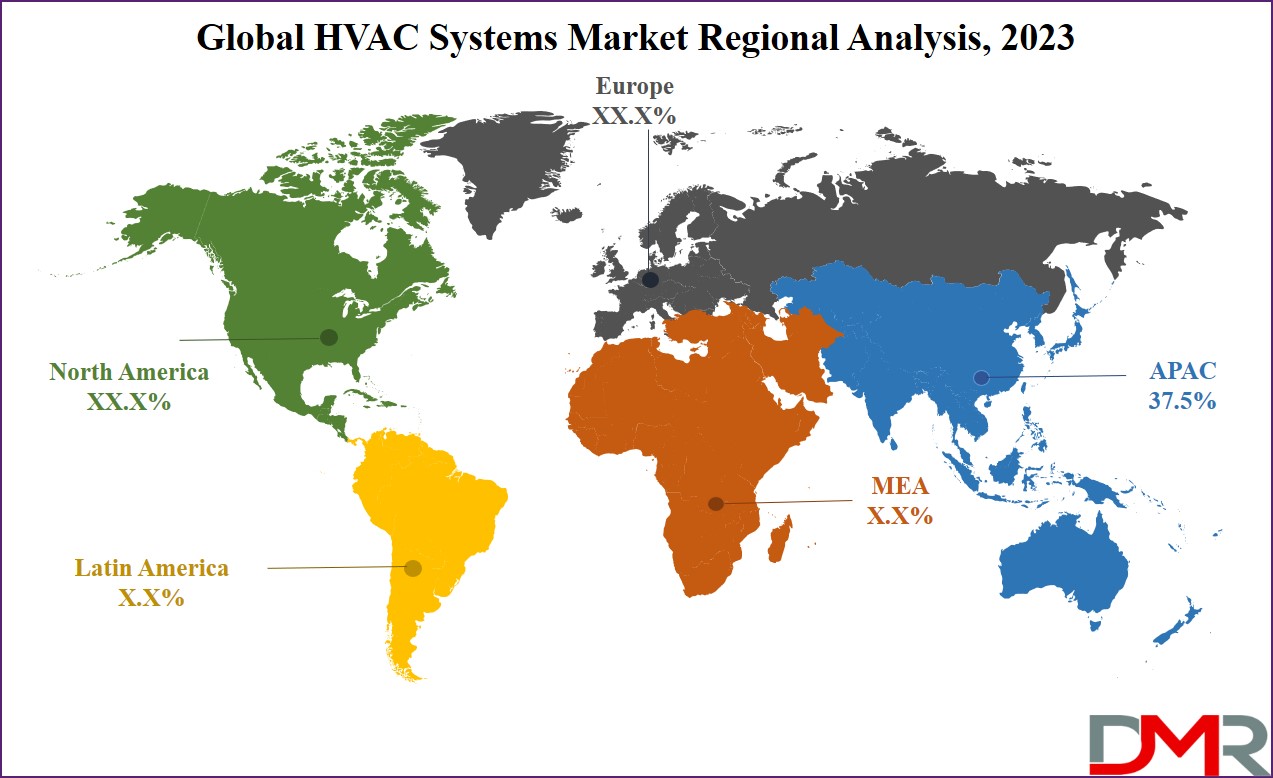New York, May 27, 2024 (GLOBE NEWSWIRE) -- Overview:
The Global HVAC Systems Market size was valued at USD 166.8 billion in 2023 and it is further anticipated to reach a market value of USD 275.0 billion by 2032, according to Dimension Market Research. The market is anticipated to register a CAGR of 5.7% during the forecast period.
The Global HVAC Systems Market is involved in HVAC systems that are specifically designed to provide indoor comfort in various settings from homes to industrial facilities, and maintain optimal air quality and temperature. They ensure healthful conditions by controlling humidity and incorporating outdoor air. These systems are vital for climate regulation, offering heating and cooling solutions while prioritizing air pressure and quality for occupant comfort and safety.
Click to Request Sample Report and Drive Impactful Decisions: https://dimensionmarketresearch.com/report/hvac-systems-market/request-sample/

Air conditioning dominated the global HVAC system market in terms of type in 2023 driven by its substantial impact on global electricity consumption, exceeding 10%. The growth is attributed to increased adoption in warm regions due to rising populations and disposable incomes. The heating equipment segment also experiences incremental growth, fueled by a shift to low-carbon alternatives and the expansion of solar-powered heat pumps, offering new opportunities.
Important Insights
- Projections suggest a substantial surge, within the global HVAC systems market as it is expected to show noteworthy growth by reaching USD 275.0 billion by 2032, which represents a significant CAGR of 5.7%, commencing from its 2023 base value of USD 166.8 billion.
- The HVAC systems market is led by the dominant air conditioning segment based on type, significantly contributing to global electricity consumption in 2023. Following air conditioning the heating equipment segment also exhibits incremental growth, driven by a shift to low-carbon alternatives and the expansion of solar-powered heat pumps, creating new opportunities.
- In terms of end users, the HVAC market is led by the residential sector, contributing the most to global revenue. Growth in multi-family residences and individual home ownership fuels expansion, with attention shifting to emerging markets due to population growth. Meanwhile, the commercial sector experiences significant growth, driven by eco-friendly technologies and automation, promising ample opportunities for future development.
- The Asia Pacific region commanded a substantial 37.5% share in the global HVAC Systems Market in 2023, driven by urbanization, population growth, and increased consumer spending. Additionally, North America and Europe have witnessed noteworthy growth in the HVAC Systems market and are expected to continue their upward trajectory in the forecasted period.
Global HVAC Systems Market: Trends
- Demand for Energy-Efficient Solutions: There's a main trend towards energy-efficient HVAC systems driven by higher environmental concerns and cost-saving initiatives, supporting manufacturers to develop and market more efficient products with advanced technologies like variable speed compressors and smart controls.
- Integration of IoT and Smart Technologies: The integration of the Internet of Things (IoT) and smart technologies into HVAC systems is gaining momentum, enabling remote monitoring, predictive maintenance, and optimization of system performance, thereby enhancing efficiency and minimizing operational costs.
- Focus on Indoor Air Quality (IAQ): With Increase in awareness of the importance of indoor air quality for health and productivity, there's a growth in demand for HVAC systems equipped with advanced filtration, ventilation, and purification technologies to maintain clean and healthy indoor environments, mainly in commercial buildings, schools, and healthcare facilities.
- Shift towards Renewable Energy Sources: The switch towards renewable energy sources like solar and geothermal energy is influencing the HVAC market, with higher adoption of heat pumps and other systems that use renewable energy for heating and cooling, driven by sustainability goals and government incentives.
HVAC Systems Market: Competitive Landscape
In the global HVAC systems market, major companies are using inorganic growth strategies like strategic partnerships and mergers to improve their market presence. Original Equipment Manufacturers (OEMs) prioritize technological developments and energy efficiency for short-term profitability. As this market is growing major market players are focusing on research and development to introduce advanced and unique products, to gain a competitive edge over others. In addition, companies align product development with regional regulatory norms to minimize business risks associated with non-compliance.
Some of the major players in the market include LG Electronics, Johnson Controls, Emerson Electric, Samsung, Daikin Industries, Mitsubishi Electric, and more.
Some of the prominent market players:
- LG Electronics
- Johnson Controls
- Emerson Electric
- Samsung
- Daikin Industries
- Mitsubishi Electric
- Bosch
- Zehnder
- Systemair
- Trane
- Other Key Players
Transform your business approach with strategic insights from our report. Get in touch to request our brochure today at https://dimensionmarketresearch.com/report/hvac-systems-market/download-reports-excerpt/
HVAC Systems Market Scope
| Report Highlights | Details |
| Market Size (2023) | USD 166.8 Bn |
| Forecast Value (2032) | USD 275.0 Bn |
| CAGR (2023-2032) | 5.7% |
| Leading Region in terms of Revenue Share | Asia Pacific |
| Percentage of Revenue Share by Leading Region | 37.5% |
| Historical Data | 2018 - 2023 |
| Forecast Data | 2025 – 2032 |
| Base Year | 2023 |
| Estimate Year | 2024 |
| Segments Covered | By Type, By End User |
| Regional Coverage | North America, Europe, Asia Pacific, Latin America, Middle East & Africa (MEA) |
Segment Analysis:
Based on end users residential dominated this segment of the HVAC Systems market, as they hold 48.7% of the market share in 2023. The rise in the number of owners of multifamily residents and individual homes has created a new growth opportunity for this market. Now as the world is going through rapid urbanization this market is also facing rapid growth and expansion. The commercial HVAC sector shows notable growth, driven by eco-friendly technologies and automated systems, offering substantial opportunities in the future.

HVAC Systems Market Segmentation
By Type
- Heat Pump
- Air Conditioning Equipment
- Heating Equipment
- De-humidifiers/Humidifiers
By End User
- Residential
- Commercial
- Industrial
Click to Request Sample Report and Drive Impactful Decisions at https://dimensionmarketresearch.com/report/hvac-systems-market/request-sample/
Global HVAC Systems Market: Driver
- Energy Efficiency Regulations: Strict regulations across the world are pushing for energy-efficient HVAC systems, driving the adoption of newer technologies and innovative designs to meet efficiency standards.
- Technological Advancements: Rapid development in HVAC technologies, including smart thermostats, variable refrigerant flow (VRF) systems, and advanced control systems, are improving performance, comfort, and energy efficiency, thereby encouraging market growth.
- Increasing Urbanization and Construction: Urbanization, along with growth in construction activities globally, mainly in emerging economies, is driving the demand for HVAC systems in commercial, residential, and industrial sectors, as buildings need efficient climate control solutions.
- Growing Awareness of Indoor Air Quality: Growth in the awareness about indoor air quality and its impact on health is driving the need for HVAC systems with advanced filtration, ventilation, and purification capabilities, majorly in healthcare facilities, schools, offices, and residential buildings.
Global HVAC Systems Market: Restraints
- High Initial Investment Costs: The initial costs associated with purchasing and installing HVAC systems can be very high, acting as a deterrent for some consumers and businesses, mainly in regions with budget constraints or uncertain economic conditions.
- Market Saturation in Developed Regions: In developed markets such as North America and Western Europe, the HVAC market may experience saturation, limiting high growth opportunities as replacement cycles lengthen and new installations slow down due to market maturity.
- Supply Chain Disruptions: Disruptions in the supply chain, whether due to geopolitical tensions, natural disasters, or pandemics, can cause delays in manufacturing, distribution, and installation of HVAC equipment, impacting market growth and project growth.
- Environmental Concerns and Regulations: The rise in environmental concerns and stricter regulations related to refrigerants and greenhouse gas emissions creates challenges for HVAC manufacturers and users, needing compliance with changing standards and the development of eco-friendly alternatives, which may increase costs and complexity.
Global HVAC Systems Market: Opportunities
- Rising Demand for Retrofitting and Upgrades: The need to change aging HVAC systems with more energy-efficient and technologically developed solutions presents major opportunities for HVAC manufacturers and service providers to provide retrofitting and upgrade services.
- Emergence of Smart HVAC Solutions: The increase in adoption of smart technologies, like IoT-enabled devices and building automation systems, provides opportunities for the integration of smart HVAC solutions, offering enhanced control, monitoring, and optimization capabilities.
- Expansion in Emerging Markets: Rapid urbanization, increasing disposable incomes, and infrastructure development in emerging markets provide rewarding opportunities for HVAC manufacturers to expand their presence and tap into the growing demand for climate control solutions.
- Focus on Indoor Air Quality and Health: Rising awareness of indoor air quality and its impact on health, mainly in the wake of pandemics, providing opportunities for HVAC companies to develop and market advanced air filtration, purification, and ventilation systems to meet the changing needs of consumers and businesses.
Regional Analysis
The Asia Pacific leads the global HVAC systems market with a 37.5% revenue share in 2023 driven by urbanization, population growth, and heightened consumer spending. The commercial sector's recent expansion adds potential for continued regional advancement. Further, North America and Europe are also experiencing notable growth in the HVAC Systems market, and further expansion is anticipated in the forecasted period, indicating sustained market development in these regions.

By Region
North America
- The U.S.
- Canada
Europe
- Germany
- The U.K.
- France
- Italy
- Russia
- Spain
- Benelux
- Nordic
- Rest of Europe
Asia-Pacific
- China
- Japan
- South Korea
- India
- ANZ
- ASEAN
- Rest of Asia-Pacific
Latin America
- Brazil
- Mexico
- Argentina
- Colombia
- Rest of Latin America
Middle East & Africa
- Saudi Arabia
- UAE
- South Africa
- Israel
- Egypt
- Rest of MEA
Purchase the Competition Analysis Dashboard Today at https://dimensionmarketresearch.com/checkout/hvac-systems-market/
Recent Developments in the HVAC Systems Market
- November 2023: Daikin introduced the Emura system which combines air purification with precise heating and cooling in a sleek design, suitable for various indoor spaces, emphasizing efficiency and temperature control in living rooms and offices.
- November 2023: Montana Technologies and the Department of Energy (DOE) have achieved a breakthrough in HVAC and water harvesting technology. Montana's AirJoule tech provides affordable, eco-friendly HVAC and water solutions, using MOFs to harvest renewable energy and reduce power consumption by 75% and carbon emissions.
- November 2023: Trane Technologies achieves a milestone, delivering over one million sustainable HVAC units with low-carbon steel, reducing emissions in homes, schools, data centers, and hospitals. The initiative aligns with the company's commitment to net zero by 2050 and sustainability goals.
- September 2023: Johnson Controls-Hitachi introduced the air365 Hybrid dual fuel system, merging a heat pump and furnace for year-round efficient, eco-friendly home comfort. The system optimizes performance, reducing carbon emissions and qualifying for rebates.
- September 2023: BrainBox AI and Trane Technologies partner to integrate autonomous decarbonization tech into Trane's building automation system, focusing on HVAC systems for North American multi-site retailers. The collaboration aims to cut emissions and costs using real-time control commands guided by AI predictions.
Browse More Related Reports
The Global Mobile Security Market is expected to reach a value of USD 6.3 billion in 2023, and it is further anticipated to reach a market value of USD 32.7 billion by 2032 at a CAGR of 20.1%.
The Global Mass Notification System Market is expected to reach a value of USD 13.1 billion in 2023, and it is further anticipated to reach a market value of USD 64.5 billion by 2032 at a CAGR of 19.4%.
The Global Holographic Display Market is expected to reach a value of USD 3.0 billion in 2023, and it is further anticipated to reach a market value of USD 20.7 billion by 2032 at a CAGR of 23.9%.
The Global Mobile Cranes Market is expected to reach a value of USD 19.8 billion in 2023, and it is further anticipated to reach a market value of USD 36.3 billion by 2032 at a CAGR of 7.0%.
The Global Natural Language Processing Market is expected to reach a value of USD 21.0 billion in 2023, and it is further anticipated to reach a market value of USD 176.0 billion by 2032 at a CAGR of 26.6%.
The Global Anomaly Detection Market is expected to reach a value of USD 5.3 billion in 2023, and it is further anticipated to reach a market value of USD 21.9 billion by 2032 at a CAGR of 17.1%.
The Global Container Security Market is expected to reach a value of USD 2.1 billion in 2023, and it is further anticipated to reach a market value of USD 16.2 billion by 2032 at a CAGR of 25.2%.
The Global Cybersecurity Mesh Market is expected to reach a value of USD 1.7 billion in 2023, and it is further anticipated to reach a market value of USD 18.4 billion by 2032 at a CAGR of 30.2%.
The Global Data Centric Security Market is expected to reach a value of USD 5.7 billion in 2023, and it is further anticipated to reach a market value of USD 42.4 billion by 2032 at a CAGR of 25.1%.
The Global Managed Security Services Market is expected to reach a value of USD 32.9 billion in 2023, and it is further anticipated to reach a market value of USD 97.1 billion by 2032 at a CAGR of 12.8%.
About Dimension Market Research (DMR)
Dimension Market Research (DMR) is a market research and consulting firm based in India & US, with its headquarters located in the USA (New York). The company believes in providing the best and most valuable data to its customers using the best resources analysts into work, to create unmatchable insights into the industries, and markets while offering in-depth results of over 30 industries, and all major regions across the world. We also believe that our clients don’t always want what they see, so we provide customized reports as well, as per their specific requirements to create the best possible outcomes for them and enhance their business through our data and insights in every possible way.
